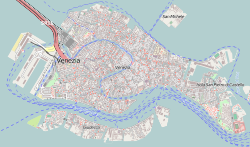| San Marcuola Santi Ermagora e Fortunato | |
|---|---|
 Facade facing Grand Canal | |
| Religion | |
| Affiliation | Roman Catholic |
| Year consecrated | 1779 |
| Status | Active |
| Location | |
| Location | Venice, Italy |
| Geographic coordinates | 45°26′34″N12°19′43″E / 45.442754°N 12.328654°E |
| Architecture | |
| Architect(s) | Giorgio Massari |
| Type | Church |
| Style | Neoclassicism |
| Groundbreaking | 13th century, 1730 (reconstruction) |
| Completed | 1766 (facade incomplete) |


The church of San Marcuola is a religious building facing the Grand Canal and located in the sestiere of Cannaregio in Venice, Italy. It is dedicated to the saints Hermagoras and Fortunatus ("Marcuola" is a Venetian contraction of "Ermacora"). Palazzo Memmo Martinengo Mandelli is a neighboring building.


